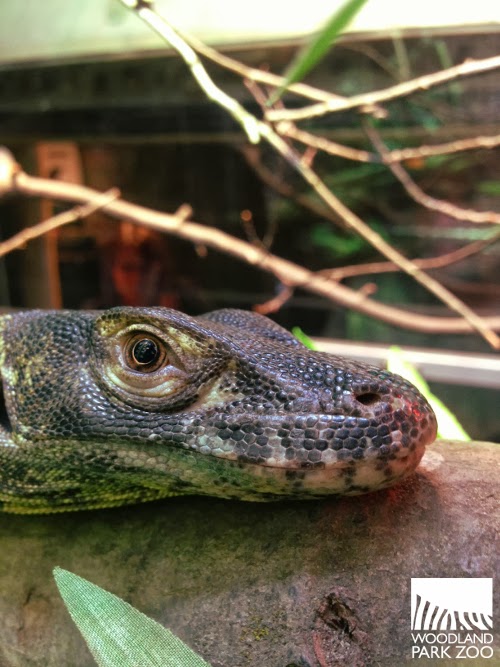Posted by: Rebecca Whitham, Communications
Even dragons start out small. Have you seen the two Komodo dragon juveniles now living at the Adaptations Building at the zoo? Born in January at the Memphis Zoo as part of the Species Survival Plan for this endangered species, the duo moved here this summer to be raised in our ample dragon digs.
Hard to imagine these tiny critters, who each weigh in at about one-and-a-half pounds (650 grams), will one day be as big as our 15-year-old male Selat, who is 110 pounds (50 kilograms). Though, they won’t reach adult size until they're about 7 to 10 years old!
Once these dragons mature, they’ll continue to participate in the Species Survival Plan and may move on to other zoos if they are matched up with a partner for breeding.
It’ll be some time before they are ready for that next step. For now, the juveniles are on view next door to Selat. We've built a little apartment for them inside one of the Komodo dragon exhibits that’s just right for their small size and juvenile temperament. It includes some tree branches for perching and UV light bulbs for sunning.
It’s hard to miss Selat when you are at the exhibit, but you may have to put in a little extra work to spot the young ones. If you don’t see them right away, try looking at the top of their cage, where they may be busy basking in the light. Not there? Try looking at the bottom of the cage. Look everywhere, honestly. These lizards like to cruise around a lot, so they could be anywhere inside their enclosure!
You might spot a keeper inside the exhibit with the young Komodo dragons at times, which usually means some training is going on. Komodo dragons, just like other monitor lizard species, are very intelligent. Monitors—lizards belonging to the family Varanidae—can learn basic tricks, such as coming to a target or responding to their name or other verbal commands. They are widely thought to be the most intelligent of reptiles. Our keepers train the Komodos to shift between spaces and follow a special targeting stick. These learned behaviors make it easier for the keeper staff to manage these potentially dangerous animals.
When you visit these young ones, know that your trip to the zoo helps us contribute to Komodo dragon conservation in the field. Through our Wildlife Survival Fund we support a Komodo dragon research and conservation project in Indonesia, which is helping us to understand natural history and captive husbandry needs of this iconic reptile.
Even dragons start out small. Have you seen the two Komodo dragon juveniles now living at the Adaptations Building at the zoo? Born in January at the Memphis Zoo as part of the Species Survival Plan for this endangered species, the duo moved here this summer to be raised in our ample dragon digs.
Hard to imagine these tiny critters, who each weigh in at about one-and-a-half pounds (650 grams), will one day be as big as our 15-year-old male Selat, who is 110 pounds (50 kilograms). Though, they won’t reach adult size until they're about 7 to 10 years old!
Once these dragons mature, they’ll continue to participate in the Species Survival Plan and may move on to other zoos if they are matched up with a partner for breeding.
It’ll be some time before they are ready for that next step. For now, the juveniles are on view next door to Selat. We've built a little apartment for them inside one of the Komodo dragon exhibits that’s just right for their small size and juvenile temperament. It includes some tree branches for perching and UV light bulbs for sunning.
It’s hard to miss Selat when you are at the exhibit, but you may have to put in a little extra work to spot the young ones. If you don’t see them right away, try looking at the top of their cage, where they may be busy basking in the light. Not there? Try looking at the bottom of the cage. Look everywhere, honestly. These lizards like to cruise around a lot, so they could be anywhere inside their enclosure!
You might spot a keeper inside the exhibit with the young Komodo dragons at times, which usually means some training is going on. Komodo dragons, just like other monitor lizard species, are very intelligent. Monitors—lizards belonging to the family Varanidae—can learn basic tricks, such as coming to a target or responding to their name or other verbal commands. They are widely thought to be the most intelligent of reptiles. Our keepers train the Komodos to shift between spaces and follow a special targeting stick. These learned behaviors make it easier for the keeper staff to manage these potentially dangerous animals.
 |
| A hidden camera captured this image of a Komodo dragon in the wild. Photo: Population Monitoring of Komodo Dragons and Capacity Building in Komodo National Park. |
When you visit these young ones, know that your trip to the zoo helps us contribute to Komodo dragon conservation in the field. Through our Wildlife Survival Fund we support a Komodo dragon research and conservation project in Indonesia, which is helping us to understand natural history and captive husbandry needs of this iconic reptile.





Comments
so much
Post a Comment